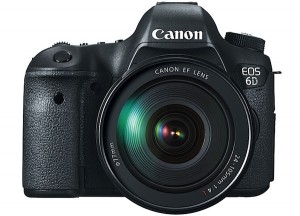Archive for the ‘Business of the Video Shooter’ Category
 What’s Going On Here?
What’s Going On Here?
Around the country and world, BlackMagic seems to have no trouble attracting folks to its showcase events, like this one in Burbank last Wednesday.
The winning formula? Okay, a free lunch certainly helps.
But so does appealing to the burgeoning number of former DSLR shooters and low to mid-range producers looking to move up to more professional gear. The low end of the market has now all but displaced the once dominant mid range corporate and broadcast segments that were Sony and Panasonic’s former bread and butter.
Responding to the Isness of the market BlackMagic is capitalizing on this newest trend in a big way.

While Sony, Panasonic, and other camera makers, struggle mightily for customers’ attention, BlackMagic seems to have no difficulty doing so.
 I’m Missing the Connection Here
I’m Missing the Connection Here
The data and power cables poking in and out of my MacBook Pro are pure crap. Take a look at how I’m managing my AC charger cord. I’ve added three cable ties over a sleeve of black camera tape to ensure adequate stress relief and thus forestall the eruption of arcs and sparks from the broken connection.
Why can’t cable manufacturers simply provide sufficient stress relief in the first place?
The matter of diseased trouble-prone cables is not a new phenomenon. After 35 years in the business I know from hard-won experience that 90% of failures in the field are due to defective cables and connectors. Thinking about it now my ARRI 16SR in 1976 was a true godsend. The camera utilized onboard batteries that eliminated completely failure-prone cables and plugs. It gave me great peace of mind that this disproportionate cause of failure was gone forever.
Thunderbolt is an impressive technology and we’ve grown to rely on the less than robust cables for our most critical tasks from off-loading original camera footage to preparing our backup volumes. With data rates up to 40Gbps in Thunderbolt3 the flow of data is sensitive to a range of cable snafus, especially at the point where the cable enters the rigid connector where most failures due to fatigue occur.
For manufacturers, the cost of producing cables with proper stress relief might amount to a few pennies per unit, but as shooters and content creators whose business is capturing, transferring, and managing critical data, the extra dollar or two per cable at retail is worth it, if only to avoid the indignity of having to affix a raft of cable ties simply to ensure a solid and reliable connection.

A cable usually fails at the point it enters the solid connector. Affixing a series of plastic cable ties can provide increased stress relief and help forestall an intermittent connection.
 Children of the Desert
Children of the Desert
I’m in Abu Dhabi this week continuing my ongoing travels around the globe offering camera workshops and pontificating about one irrelevant thing or another. This morning a major sandstorm blew in from Saudi Arabia and completely enveloped the NYU campus where I’m currently holed up.
The extremely fine sand less than 50 microns in diameter is highly abrasive and can lodge dangerously deep in one’s lungs. It is also damaging to cameras and especially camera lenses, a lesson learned the hard way by many filmmakers and shooters in the region who are drawn inexorably, like I am, to the eerie other world feeling imparted on the landscape.

Emirati children visiting the NYU campus in Abu Dhabi navigate an early morning sandstorm 3 April 2015.
 Smaller Is Better Sometimes
Smaller Is Better Sometimes
If your bread and butter is shooting news, non-fiction, or documentaries, which covers at least three-quarters of us, a smallish-sensor camcorder fitted with a 1/3-inch, ½-inch, or 2/3-inch sensor makes a lot of sense.
Sony’s new PXW-X180 fitted with a 1/3-type sensor means in terms of imager size you can actually find and hold critical focus at the long end of its long 25X integrated zoom. I admit the whisker-thin narrow depth of field look currently in vogue offers some storytelling advantage: a blurry background with a shallow focus can help direct the viewer’s eye to what’s important inside the frame.
For documentary non-fiction shooters however our emphasis ought not to be so much on achieving the least amount of depth of field but rather how to capture the most compelling close ups. For those of us who earn a living every day in the non-fiction genre we know that close ups account for 80%-90% of our storytelling, which usually require longer focal length lenses with an inherently narrow depth of field.
Thus the full-frame sensor so ardently demanded by many shooters today may work against the exercise of a documentarian’s good craft; the extreme narrow focus in close ups may render such critical scenes objectionably soft, and thus communicate an amateurish feel to viewers.
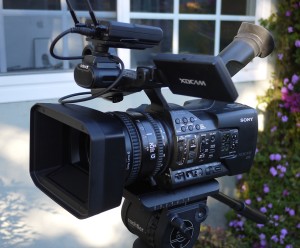
Sony’s new PXW-X180 features a very out of fashion 1/3-type sensor. Just what you may very well need for your next documentary project!
 Among the Flamingos at NAB 2014
Among the Flamingos at NAB 2014
Just wrapped NAB 2014 in Vegas. Really great seeing many old and new friends in one place! Panasonic’s new Varicams are sweet and I was pleased to have had the opportunity to present them to the public. I even had two guys in my audience who laughed at my jokes! I was thinking it was cool. So what if they didn’t speak English.
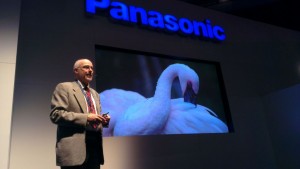
Barry Braverman presents the new Varicams among the flamingos at NAB 2014 in Las Vegas.
 Who Needs 4K?
Who Needs 4K?
NAB 2013 has come and gone and the prevailing themes this year were clear: cloud-based storage and collaboration and the advent of 4K acquisition. My question is who needs 4K? If you’re shooting a movie destined for the big screen then 4K origination certainly makes sense along with use of the appropriate lenses and a lightly compressed recording format. Short of cinema applications and perhaps broadcast for cutting out multiple HD frames the point of 4K acquisition escapes me.
I expressed this perspective at a recent trade gathering of cinematographers and manufacturers and was roundly booed. My father who bathed extremely infrequently often questioned ‘why clean is better?’ I would like to offer the analogous thought for the vast majority of today’s shooters: Why is more resolution better? Why is 4K desirable?
Please tell me. I’d like to know.
 Motivating the (supposedly) Unmotivated
Motivating the (supposedly) Unmotivated
This week I have been providing basic camera visual storytelling training to staff cameramen at television broadcast facilities in Kuala Lumpur and Singapore. Having offered such training numerous times in the past for the commercial production community I was informed in Southeast Asia that the news cameramen are particularly lazy, unmotivated, and lacking in creative energy.
Nothing could be further from the truth! What I found at the news channels in Malaysia and Singapore were teams of motivated craftsmen eager to express themselves with more cinematic penache. Curiously I discovered the same thing among the producers and writers who also participated in the training. From every quarter there seemed to a pronounced willingness to produce more visually compellling work in the news and current affairs genre. What is missing it seems is a clear mission statement from news directors, station management, and labor unions, that it’s worth the effort for a shooter to try hard and produce outstanding work. It’s not a question of money; it’s really a matter of recognition, that the managers who mete out the shooters’ daily assignments will welcome and appreciate the extra effort and higher standard.
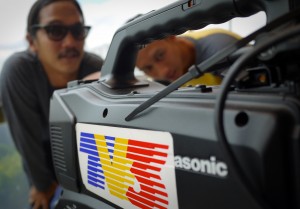
News crews in SE Asia are eager, able, and ready, to provide more compelling visual content, if station managers will simply allow them.
 3D Interest Surging (Again) in SE Asia
3D Interest Surging (Again) in SE Asia
We’ve seem this before in 2010 and now again in 2013: a renewed interest in 3D workshops and training. This week I am finally out of Dhaka and leading back-to-back 3D training sessions in Singapore, at MediaCorps’ educational academy SMA, and at NYU Tisch Asia.
The reason for the surge in interest seems counter-intuitive. The recent success of Life of Pi notwithstanding theatrical 3D has been losing ground and audiences for several years. The anticipated boom in demand however for non-theatrical 3D programming appears to be the big factor this time with the arrival of a 3D iPad and iPhone in late 2013 or 2014. There is an imperative for media training institutions across the region to remain relevant and on the cutting edge as they see it appropriate once again to offer 3D training opportunities for their students.
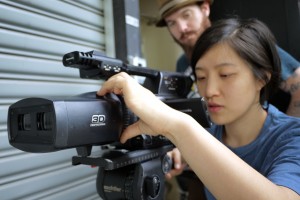
NYU Tisch students practice their 3D skills during a workshop at the university’s Singapore campus 23 Feb 2013.
 The Spirit of Southeast Asia
The Spirit of Southeast Asia
This month I am leading a series of camera workshops in Kuala Lumpur and am duly impressed by the spirit of my students and overall level of media activity here. While the mood in the US and UK can only be described as glum it is certainly not the case here where aspiring filmmakers and content creators of every type appear eager to learn the old cinematographer’s skills in combination with the new camera technologies.
In the coming months I will be venturing on to Hyderabad and Dhaka, where demand for skills and training is high. With four new television stations having come on line in Dhaka this year facility managers are hard pressed to find sufficient qualified workers to fill the available positions. No doubt the economic growth in Malaysia and throughout the SE Asia region is fueling the demand for media professionals but it is also an intrinsic yearning and high value placed on education in general in these societies that are playing a large role.
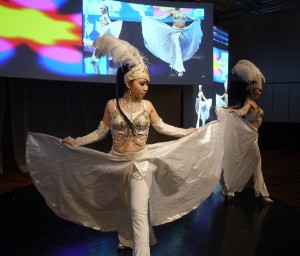
A stage show at Panasonic Showcase Malaysia artfully blends the traditions of regional dance and the latest display technologies. 13 December 2012.
 The DSLR Wannabes
The DSLR Wannabes
The line between still and moving is rapidly blurring as the latest generation DSLRs become more robust and capable as professional video cameras. The addition of SMPTE timecode in the Canon 6D and Panasonic GH3, in addition to manual audio levels and more extensive control over exposure and frame rates, suggest that that the line may disappear entirely before very long.
The DSLR can’t thwart the laws of physics, however, and the camera’s diminutive bodies and lack of proper heat sinks cannot quite yet tackle the processing loads demanded by today’s sophisticated shooters. To shoot HD RAW the DSLR would need to increase its on-board processing power on the order of 20 times, a development that is simply not in the memory cards anytime soon.
So the DSLR for all its expanded video capabilities and functions will remain several orders of magnitude below a true video camera for the foreseeable future. If you study the media landscape and examine popular camcorders like the Panasonic AF100, Sony FS100, and Canon C500, you see cameras that have been profoundly influenced by the DSLR.
No doubt that will continue to be the case as DSLR wannabes multiply and join the fray in 2013. I don’t see it being any other way, given that Canon appears to be the only profitable manufacturer of cameras these days.
